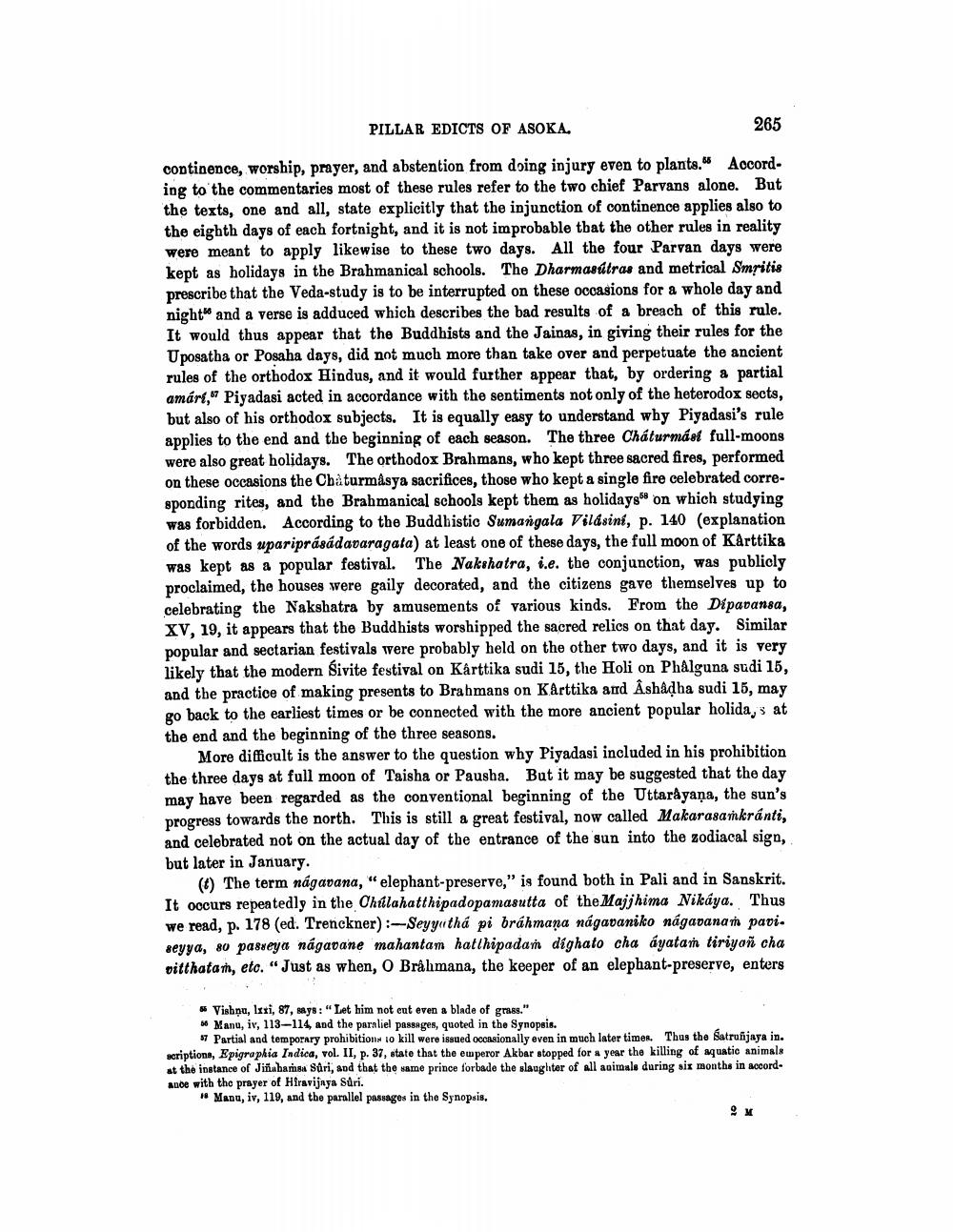________________
PILLAR EDICTS OF ASOKA.
265
continence, worship, prayer, and abstention from doing injury even to plants. According to the commentaries most of these rules refer to the two chief Parvans alone. But the texts, one and all, state explicitly that the injunction of continence applies also to the eighth days of each fortnight, and it is not improbable that the other rules in reality were meant to apply likewise to these two days. All the four Parvan days were kept as holidays in the Brahmanical schools. The Dharmasútras and metrical Smritis prescribe that the Veda-study is to be interrupted on these occasions for a whole day and night and a verse is adduced which describes the bad results of a breach of this rule. It would thus appear that the Buddhists and the Jainas, in giving their rules for the U posatha or Posaha days, did not much more than take over and perpetuate the ancient rules of the orthodox Hindus, and it would further appear that, by ordering a partial amári," Piyadasi acted in accordance with the sentiments not only of the heterodox sects, but also of his orthodox subjects. It is equally easy to understand why Piyadasi's rule applies to the end and the beginning of each season. The three Cháturmásí full-moons were also great holidays. The orthodox Brahmans, who kept three sacred fires, performed on these occasions the Chàturmasya sacrifices, those who kept a single fire celebrated corresponding rites, and the Brahmanical schools kept them as holidays on which studying was forbidden. According to the Buddhistic Sumangala Vilasini, p. 140 (explanation of the words upariprasádavaragata) at least one of these days, the full moon of Kårttika was kept as a popular festival. The Nakshatra, i.e. the conjunction, was publicly proclaimed, the houses were gaily decorated, and the citizens gave themselves up to celebrating the Nakshatra by amusements of various kinds. From the Dipavansa, XV, 19, it appears that the Buddhists worshipped the sacred relics on that day. Similar popular and sectarian festivals were probably held on the other two days, and it is very likely that the modern sivite festival on Karttika sudi 15, the Holi on Phålguna sudi 15, and the practice of making presents to Brahmans on Karttika and Ashadha sudi 15, may go back to the earliest times or be connected with the more ancient popular holida, s at the end and the beginning of the three seasons.
More difficult is the answer to the question why Piyadasi included in his prohibition the three days at full moon of Taisha or Pausha. But it may be suggested that the day may have been regarded as the conventional beginning of the Uttarayaņa, the sun's progress towards the north. This is still a great festival, now called Makarasamkranti, and celebrated not on the actual day of the entrance of the sun into the zodiacal sign, but later in January.
() The term nagavana, "elephant-preserve," is found both in Pali and in Sanskrit. It occurs repeatedly in the Chulahatthipadopamasutta of the Majjhima Nikaya. Thus we read, p. 178 (ed. Trenckner) :--Seyy thá pi brahmana nágavaniko nagavanan padi. seyya, 80 passeya nagavane mahantam hatthipadan dighato cha ayatan tiriyon cha vitthatan, etc. "Just as when, 0 Brahmana, the keeper of an elephant-preserve, enters
- Vishna, Isti, 87, Mys: "Let him not eat even a blade of grass."
Manu, iv, 113-114, and the paraliel passages, quoted in the Synopsis.
* Partial and temporary prohibitions to kill were issued occasionally even in much later time. Thus the Satrusijaya in. seriptions, Epigraphia Indica, vol. II, p. 37, state that the emperor Akbar stopped for a year the killing of aquatic animals at the instance of Jiñabans Sari, and that the same prince forbade the slaughter of all animals during six months in accordance with the prayer of Hiravijaya Sûri.
# Manu, iv, 119, and the parallel passages in the Synopsis,




